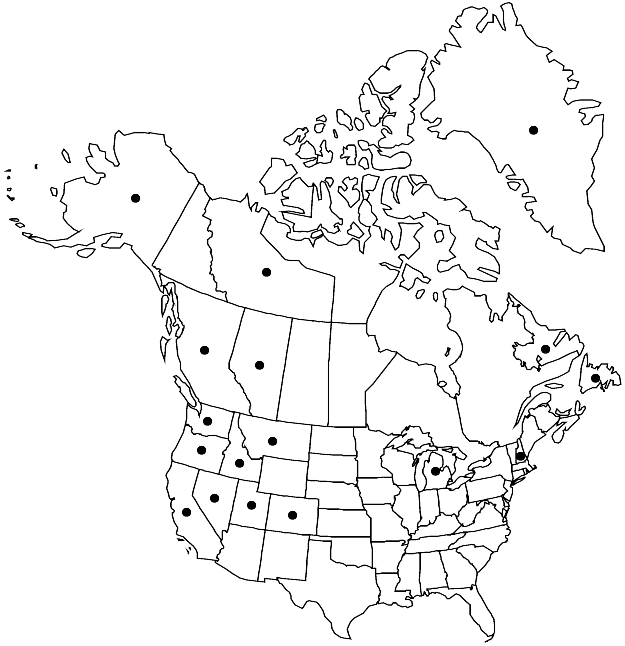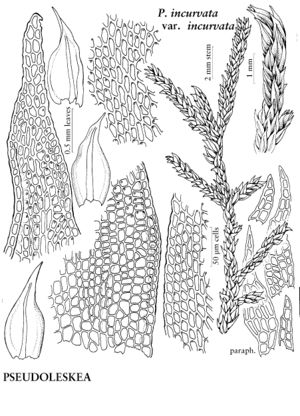Pseudoleskea incurvata
Hedwigia 50: 313. 1911.
Plants medium-sized to large, in thick mats, green, yellow-green, orange-green, or rarely black-green. Stems with branches robust, julaceous, apices curving up; central strand present; paraphyllia many, filamentous to foliose, branched. Leaves appressed to somewhat erect when dry, erect-spreading when moist, glossy or dull, ovate to ovate-lanceolate, asymmetric, usually falcate to falcate-secund, 0.8–2(–2.5) mm; margins strongly and narrowly recurved to near acumen; apex abruptly acute to short- or rarely long-acuminate, hair-point absent; costa subpercurrent to percurrent, orange-green, sometimes sinuate; alar cells transversely elongate to quadrate, region large; medial laminal cells heterogeneous, elliptic or isodiametric, to 25 µm, 1–2(–3):1, opaque or sometimes pellucid, prorate to near base, lumina smaller than 8 µm, walls firm to strongly incrassate, not pitted; apical cells 1–2:1; juxtacostal cells somewhat shorter than more distal cells, walls not pitted. Capsule erect to suberect, symmetric, 1–2.5 mm; endostome basal membrane 1/4–1/3 exostome length, segments shorter than exostome, cilia 1 or 2. Spores 10–20 µm.
Distribution

North America, Eurasia, North Temperate Zone, moderate to high elevations.
Discussion
Varieties 11 (3 in the flora).
Pseudoleskea incurvata is a complex and highly variable species; the capsules mature in summer. Most plants can be distinguished from P. radicosa by the thick-walled proximal and medial laminal cells that are mostly short, and by the relatively short cells in the acumen. Although there are intermediate specimens, the three varieties are often quite distinct. Combined ecological, molecular and morphological studies of the varieties are needed to determine their distinctiveness.
Selected References
None.
Lower Taxa
Key
| 1 | Plants large; leaves 1.5-2.5 mm, distinctly falcate-secund; apices long-acuminate; laminal cell prorulae indistinct. | Pseudoleskea incurvata var. gigantea |
| 1 | Plants small to medium-sized; leaves smaller than1.5 mm, straight, falcate, or falcate-secund; apices usually short-acuminate to acute; laminal cell prorulae distinct | > 2 |
| 2 | Leaves 1-1.5 mm; apices acute to short-acuminate to acuminate; medial laminal cells elliptic, corners rounded. | Pseudoleskea incurvata var. incurvata |
| 2 | Leaves 0.8-1.1 mm; apices abruptly acute to short-acuminate; medial laminal cells isodiametric, corners angular. | Pseudoleskea incurvata var. tenuiretis |
